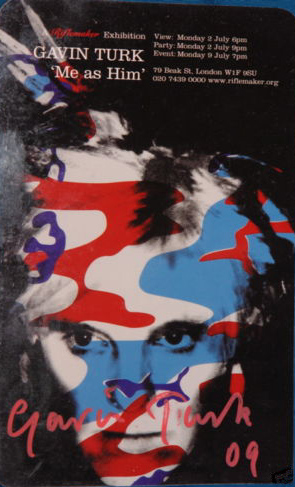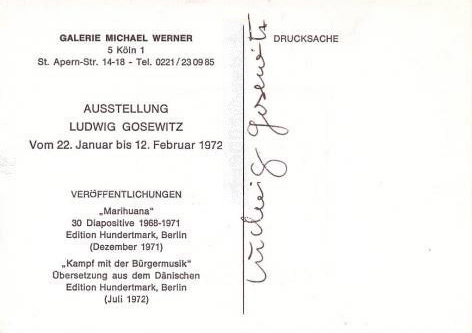|
exhibition cards signed |
|
.
|
21.09.2009 Art history can be tracked on exhibition postcards and cards printed as an invitation by a museum or gallery. These are either sent out as a commercial postcard or announcement mailed in an envelope. Sometimes cards are published by the artist. Gilbert & George sent out their self-published signed invitations. Another good example of the latter is a mailed exhibition card by Seth Siegelaub in 1969 through which he invited the receiver of the card to come to an event of Jan Dibbets in Amsterdam. It is a mailed postcard which is not so much a reproduction of an art piece, but much more an art piece in itself. The idea of describing the event to come represented in print is an early example of a "Conceptual Art postcard" and may be looked at as an artist edition, since the invitation as a document is to be looked at as the sole proof and vehicle of the idea.  Jan Dibbets, Seth Siegelaub, New York, 09.05.1969, postcard A6 Famous card in form of a 'Mailing exhibition artist postcard', published by Seth Siegelaub and sent from New York in 1969 verso: "ON MAY 9 (FRIDAY) AND MAY 30 (FRIDAY) 1969 AT 3:00 GREENWICH MEAN TIME (9:00 EST) JAN DIBBETS WILL MAKE THE GESTURE INDICATED ON THE OVERSIDE AT THE PLACE MARKED X IN AMSTERDAM, HOLLAND" Exhibition and invitation cards are most of the time one and the same; one is invited to come to the exhibition and the opening of. Prior to exhibition and invitation cards announcements came on stencils, photo copies, ink stamped paper and even on handwritten small cards that were the predecessor of the mailed and more common exhibition postcard. Another direct ancestor seems to be the envelope printed with a picture, but that is not often used in the visual arts. With the introduction of the computer digitally printed postcards became much cheaper to produce, and eventually during the financial crisis in 2008 suddenly a huge increase of evites became a new phenomenon in the art world. The relatively new electronic messages in the form of emails and sms are from a historical point of view worthwhile to collect while it is still in its very beginning to replace printed matter for a large part. The messages are multi-functional and a simple invitation is hard to find. Therefore it is most of the time confusing to understand what the emails are announcing altogether. Not only a new exhibition or a vernissage is announced, but also a press release, the launch of books, new editions, current exhibitions and even Happy New Year wishes are squeezed into the email exhibition announcement. It is interesting to see how the characteristics of the traditional exhibition and invitation card are changing. If the email is not printed by the receiver such an electronic card or invitation is fairly ephemeral and far away from the real exhibition card one can hold in his hands. Collections of such a sort are hardly known. In the near future a collection of digital exhibition messages and evites will be made public through this site, with the emphasis on mere invitation and exhibition announcements. The art postcard signed by the artist is another phenomenon. It is a collectable item, especially if the signiture is put on the front of a card next or on the reproduced art piece. On internet one can find commercial activities of buying and selling signed cards of all kinds of well-known people of all parts of our culture. From the sportsman to the Pope, any signiture may be found. Mainly for sentimental reasons these signitures of the celebrities are given to the public. In contemporary art the signed exhibition, invitation and art card create something more than just a sentimental gesture from a celebrity. Here a kind of authorisation of the image shown on the front of the card is given as if it concerns an art piece in itself. Due to the fact that art can be reproduced in a printed edition, signed by the artist, such a signed card gets an extra dimension. Not only the art piece in the museum is signed by the artist, but also the art piece in print is signed and touched by the creator. In this way the signed postcard or exhibition card has become an authorised unofficial and not numbered graphic print. There are exhibition and invitations cards, though, signed by the artist on the back of the card. These are less popular, because the signiture does not necessarily authorise the image on the front, as far as there is an image of course. The name of the artist in print is no more than a repetition by means of a handwritten signiture. For this reason a signiture on the backside of a card is less attractive for most fans and collectors. Here the emphasis is put on name and verbal exhibition details and not so much on the reproduced art piece at the front. Such signed data cards are nevertheless in my point of view interesting from a graphological a typographical point of view. The objectivity of the printed text is personalised by a signiture of the artist and in great contrast with the characteristic and physical gestures of the author's hand. On this page you will find examples of signed exhibition and invitation cards mainly produced by galleries and museums. In case a signiture on the front side of a card relates to the content of what is reproduced such cards are gladly integrated as part of the collection. KvG
2009
GAVIN TURK

2006 HEIMO ZOBERNIG 
2005
JONATHAN MEESE

2002
PIPILOTTI RIST
1972
1997
DANIELE BUETTI

LUDWIG GOSEWITZ
 |